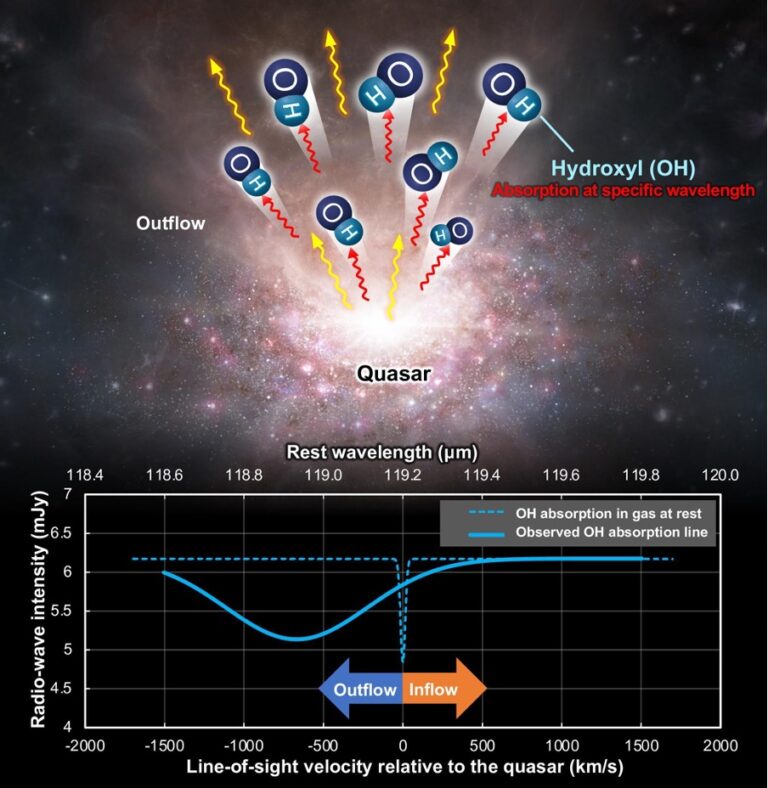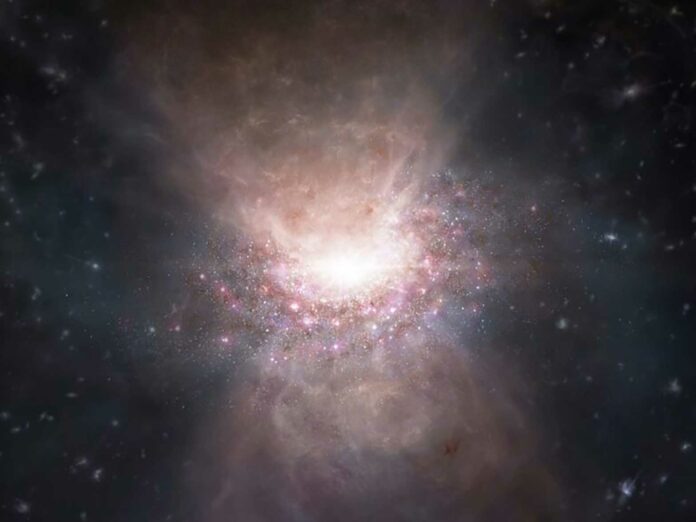Quasar feedback is a crucial mechanism in the regulation of galaxy evolution. Galaxies undergo processes such as gas acquisition from the intergalactic medium (IGM) through accretion and merging. However, some of their gas is lost due to galactic outflows, driven by feedback from phenomena like starbursts or active galactic nuclei (AGNs). This intricate interplay of acquiring and losing gas plays a fundamental role in shaping the evolution of galaxies.
A team of researchers led by Assistant Professor Dragan Salak at Hokkaido University, Assistant Professor Takuya Hashimoto at the University of Tsukuba, and Professor Akio Inoue at Waseda University have uncovered the initial evidence of star formation suppression triggered by an outflow of molecular gas in a quasar-host galaxy in the early Universe. Their observations were conducted with Chile’s Atacama Large Millimeter/submillimeter Array (ALMA).
Molecular gas is a crucial component in star formation, serving as the primary fuel. The abundance and high concentrations of molecular gas within a galaxy typically result in the formation of numerous stars. However, in galaxies hosting quasars, the ejection of this gas into intergalactic space at a rate faster than it can be consumed by star formation effectively suppresses the star formation process.
Assistant Professor Dragan Salak explains, “Theoretical work suggests that molecular gas outflows play an important role in the formation and evolution of galaxies from an early age because they can regulate star formation. Quasars, being highly energetic sources, were expected to generate powerful outflows.”

The researchers focused on the quasar J2054-0005, characterized by a very high redshift, indicating rapid separation from Earth. As one of the brightest quasars in the distant Universe, it presented an excellent opportunity for studying powerful outflows.
Utilizing the ALMA, the researchers observed the molecular gas outflow from the quasar. Given its sensitivity and frequency coverage, ALMA’s unique capabilities made it a crucial tool for detecting molecular gas outflows in the early Universe.
Salak said, “The outflowing molecular (OH) gas was discovered in absorption. This means we did not observe microwave radiation coming directly from the OH molecules; instead, we observed the radiation coming from the bright quasar—and absorption means that OH molecules happened to absorb a part of the radiation from the quasar. So, it was like revealing the presence of a gas by seeing the ‘shadow’ it cast in front of the light source.”
“Molecular gas is a very important constituent of galaxies because it is the fuel for star formation. Our findings show that quasars are capable of suppressing star formation in their host galaxies by ejecting molecular gas into intergalactic space.”
The results of this study provide the initial compelling evidence that potent molecular gas outflows from galaxies hosting quasars are indeed present and have a significant impact on galaxy evolution during the early stages of the universe.
Salak concludes, “Molecular gas is a very important constituent of galaxies because it is the fuel for star formation. Our findings show that quasars are capable of suppressing star formation in their host galaxies by ejecting molecular gas into intergalactic space.”
Journal Reference:
- Dragan Salak, et al. Molecular outflow in the reionization-epoch quasar J2054-0005 revealed by OH 119 μm observations. The Astrophysical Journal. February 1, 2024. DOI 10.3847/1538-4357/ad0df5
